torque TOYOTA YARIS 2022 Owners Manual
[x] Cancel search | Manufacturer: TOYOTA, Model Year: 2022, Model line: YARIS, Model: TOYOTA YARIS 2022Pages: 590, PDF Size: 128.6 MB
Page 284 of 590
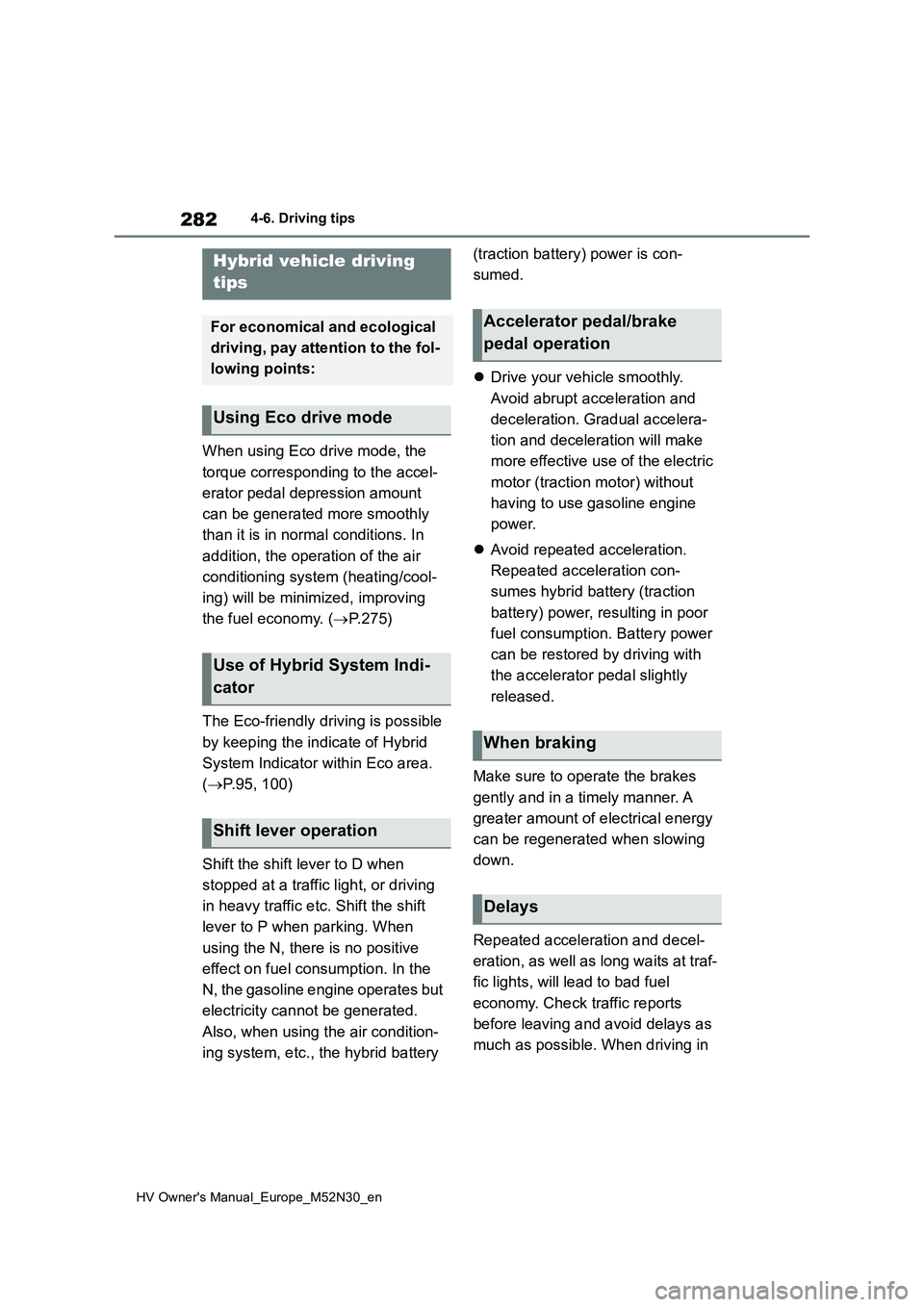
282
HV Owner's Manual_Europe_M52N30_en
4-6. Driving tips
4-6.Driving tips
When using Eco drive mode, the
torque corresponding to the accel-
erator pedal depression amount
can be generated more smoothly
than it is in normal conditions. In
addition, the operation of the air
conditioning system (heating/cool-
ing) will be minimized, improving
the fuel economy. ( P. 2 7 5 )
The Eco-friendly driving is possible
by keeping the indicate of Hybrid
System Indicator within Eco area.
( P.95, 100)
Shift the shift lever to D when
stopped at a traffic light, or driving
in heavy traffic etc. Shift the shift
lever to P when parking. When
using the N, there is no positive
effect on fuel consumption. In the
N, the gasoline engine operates but
electricity cannot be generated.
Also, when using the air condition-
ing system, etc., the hybrid battery
(traction battery) power is con-
sumed.
Drive your vehicle smoothly.
Avoid abrupt acceleration and
deceleration. Gradual accelera-
tion and deceleration will make
more effective use of the electric
motor (traction motor) without
having to use gasoline engine
power.
Avoid repeated acceleration.
Repeated acceleration con-
sumes hybrid battery (traction
battery) power, resulting in poor
fuel consumption. Battery power
can be restored by driving with
the accelerator pedal slightly
released.
Make sure to operate the brakes
gently and in a timely manner. A
greater amount of electrical energy
can be regenerated when slowing
down.
Repeated acceleration and decel-
eration, as well as long waits at traf-
fic lights, will lead to bad fuel
economy. Check traffic reports
before leaving and avoid delays as
much as possible. When driving in
Hybrid vehicle driving
tips
For economical and ecological
driving, pay attention to the fol-
lowing points:
Using Eco drive mode
Use of Hybrid System Indi-
cator
Shift lever operation
Accelerator pedal/brake
pedal operation
When braking
Delays
Page 405 of 590
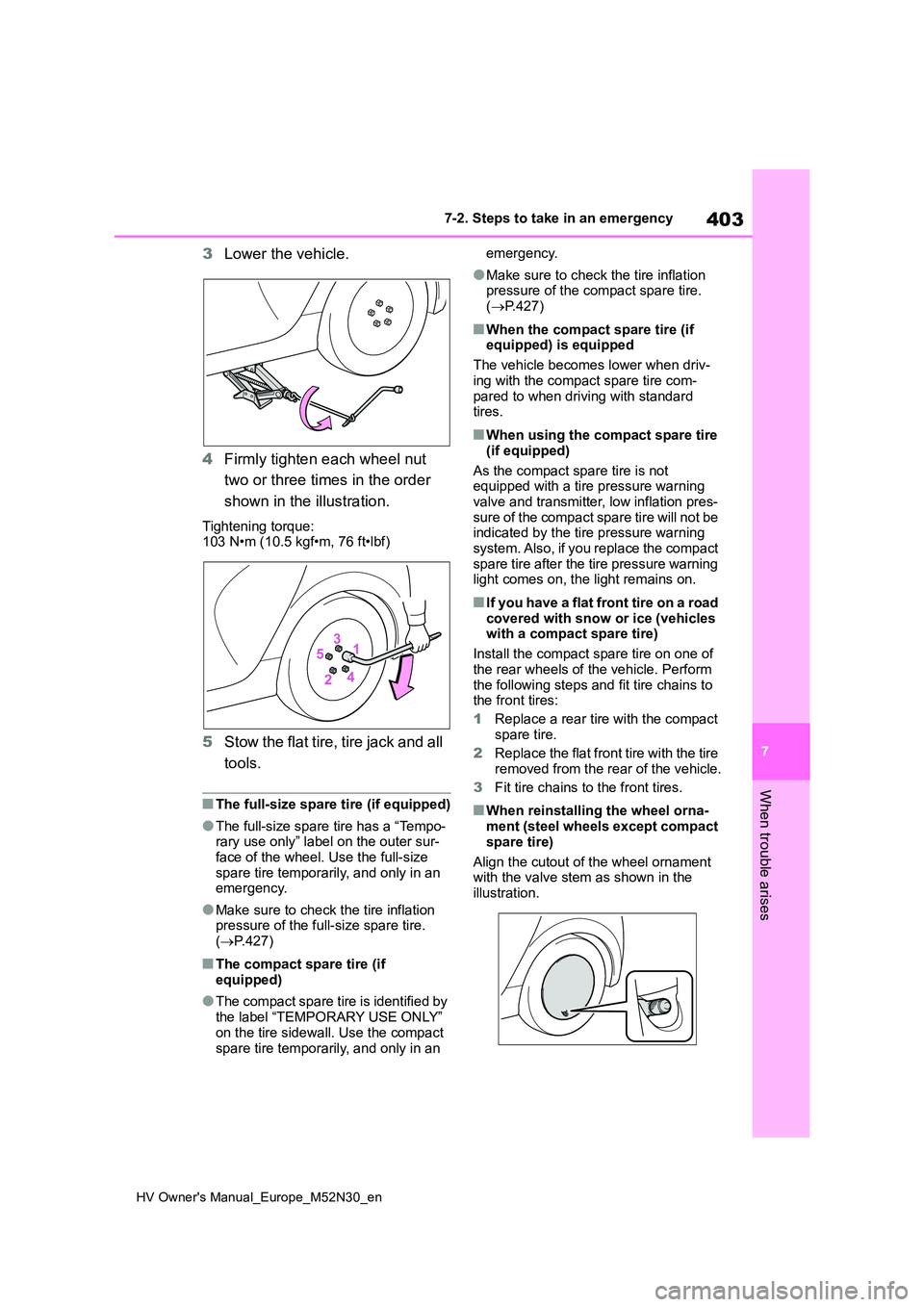
403
7
HV Owner's Manual_Europe_M52N30_en
7-2. Steps to take in an emergency
When trouble arises
3Lower the vehicle.
4 Firmly tighten each wheel nut
two or three times in the order
shown in the illustration.
Tightening torque: 103 N•m (10.5 kgf•m, 76 ft•lbf)
5 Stow the flat tire, tire jack and all
tools.
■The full-size spare tire (if equipped)
●The full-size spare tire has a “Tempo- rary use only” label on the outer sur-face of the wheel. Use the full-size
spare tire temporarily, and only in an emergency.
●Make sure to check the tire inflation pressure of the full-size spare tire. ( P.427)
■The compact spare tire (if
equipped)
●The compact spare tire is identified by
the label “TEMPORARY USE ONLY” on the tire sidewall. Use the compact
spare tire temporarily, and only in an
emergency.
●Make sure to check the tire inflation pressure of the compact spare tire.
( P.427)
■When the compact spare tire (if equipped) is equipped
The vehicle becomes lower when driv-
ing with the compact spare tire com- pared to when driving with standard tires.
■When using the compact spare tire
(if equipped)
As the compact spare tire is not equipped with a tire pressure warning
valve and transmitter, low inflation pres- sure of the compact spare tire will not be indicated by the tire pressure warning
system. Also, if you replace the compact spare tire after the tire pressure warning light comes on, the light remains on.
■If you have a flat front tire on a road
covered with snow or ice (vehicles with a compact spare tire)
Install the compact spare tire on one of
the rear wheels of the vehicle. Perform the following steps and fit tire chains to the front tires:
1 Replace a rear tire with the compact
spare tire.
2 Replace the flat front tire with the tire removed from the rear of the vehicle.
3 Fit tire chains to the front tires.
■When reinstalling the wheel orna- ment (steel wheels except compact
spare tire)
Align the cutout of the wheel ornament with the valve stem as shown in the
illustration.
Page 424 of 590
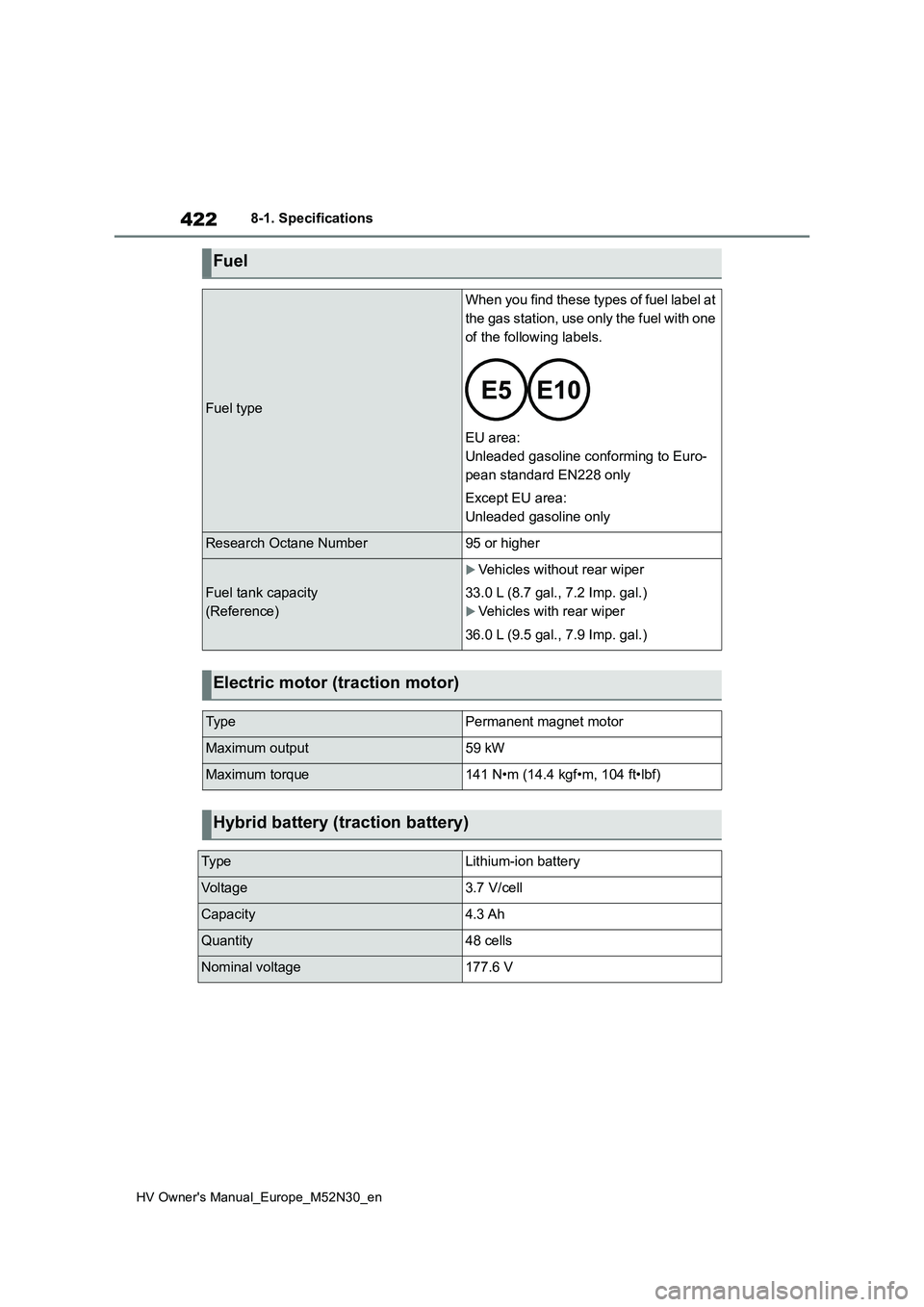
422
HV Owner's Manual_Europe_M52N30_en
8-1. Specifications
Fuel
Fuel type
When you find these types of fuel label at
the gas station, use only the fuel with one
of the following labels.
EU area:
Unleaded gasoline conforming to Euro-
pean standard EN228 only
Except EU area:
Unleaded gasoline only
Research Octane Number95 or higher
Fuel tank capacity
(Reference)
Vehicles without rear wiper
33.0 L (8.7 gal., 7.2 Imp. gal.)
Vehicles with rear wiper
36.0 L (9.5 gal., 7.9 Imp. gal.)
Electric motor (traction motor)
Typ ePermanent magnet motor
Maximum output59 kW
Maximum torque141 N•m (14.4 kgf•m, 104 ft•lbf)
Hybrid battery (traction battery)
Ty p eLithium-ion battery
Vol t ag e3.7 V/cell
Capacity4.3 Ah
Quantity48 cells
Nominal voltage177.6 V
Page 429 of 590
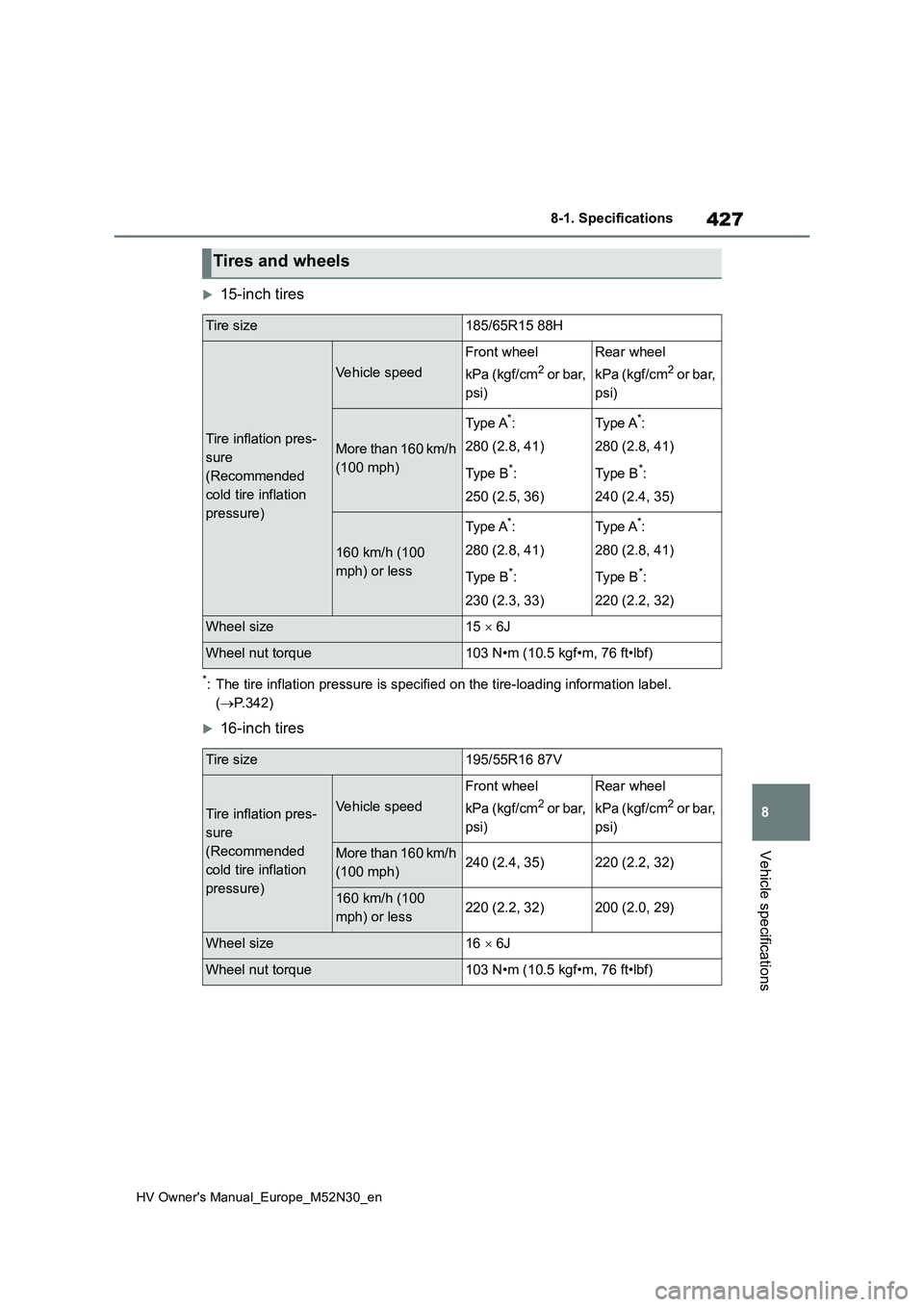
427
8
HV Owner's Manual_Europe_M52N30_en
8-1. Specifications
Vehicle specifications
15-inch tires
*: The tire inflation pressure is specified on the tire-loading information label.
( P.342)
16-inch tires
Tires and wheels
Tire size185/65R15 88H
Tire inflation pres-
sure
(Recommended
cold tire inflation
pressure)
Vehicle speed
Front wheel
kPa (kgf/cm2 or bar,
psi)
Rear wheel
kPa (kgf/cm2 o r b a r,
psi)
More than 160 km/h
(100 mph)
Typ e A*:
280 (2.8, 41)
Typ e B*:
250 (2.5, 36)
Ty p e A*:
280 (2.8, 41)
Ty p e B*:
240 (2.4, 35)
160 km/h (100
mph) or less
Typ e A*:
280 (2.8, 41)
Typ e B*:
230 (2.3, 33)
Ty p e A*:
280 (2.8, 41)
Ty p e B*:
220 (2.2, 32)
Wheel size15 6J
Wheel nut torque103 N•m (10.5 kgf•m, 76 ft•lbf)
Tire size195/55R16 87V
Tire inflation pres-
sure
(Recommended
cold tire inflation
pressure)
Vehicle speed
Front wheel
kPa (kgf/cm2 or bar,
psi)
Rear wheel
kPa (kgf/cm2 o r b a r,
psi)
More than 160 km/h
(100 mph)240 (2.4, 35)220 (2.2, 32)
160 km/h (100
mph) or less220 (2.2, 32)200 (2.0, 29)
Wheel size16 6J
Wheel nut torque103 N•m (10.5 kgf•m, 76 ft•lbf)
Page 430 of 590
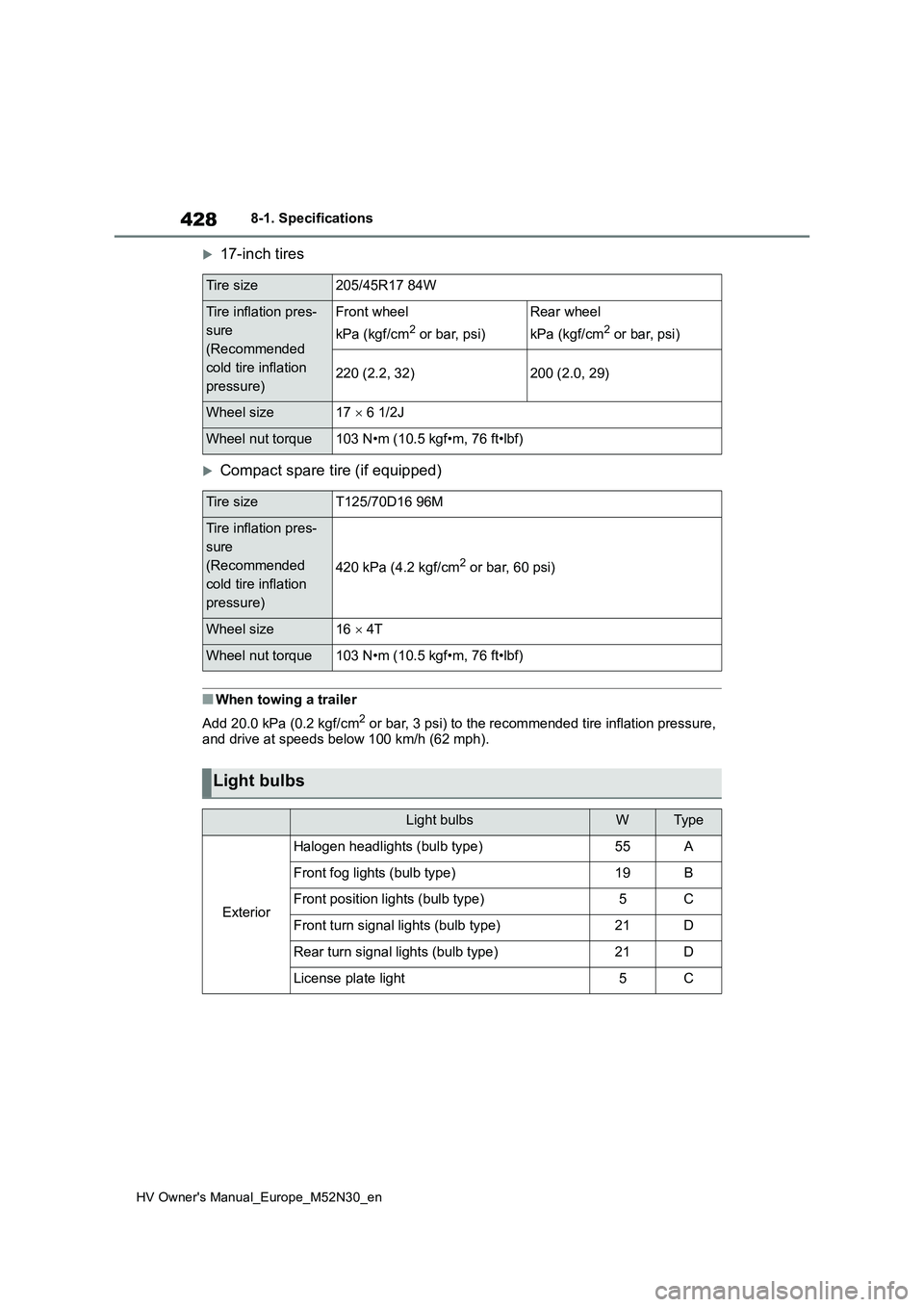
428
HV Owner's Manual_Europe_M52N30_en
8-1. Specifications
17-inch tires
Compact spare tire (if equipped)
■When towing a trailer
Add 20.0 kPa (0.2 kgf/cm2 or bar, 3 psi) to the recommended tire inflation pressure,
and drive at speeds below 100 km/h (62 mph).
Tire size205/45R17 84W
Tire inflation pres-
sure
(Recommended
cold tire inflation
pressure)
Front wheel
kPa (kgf/cm2 or bar, psi)
Rear wheel
kPa (kgf/cm2 or bar, psi)
220 (2.2, 32)200 (2.0, 29)
Wheel size17 6 1/2J
Wheel nut torque103 N•m (10.5 kgf•m, 76 ft•lbf)
Tire sizeT125/70D16 96M
Tire inflation pres-
sure
(Recommended
cold tire inflation
pressure)
420 kPa (4.2 kgf/cm2 or bar, 60 psi)
Wheel size16 4T
Wheel nut torque103 N•m (10.5 kgf•m, 76 ft•lbf)
Light bulbs
Light bulbsWTyp e
Exterior
Halogen headlights (bulb type)55A
Front fog lights (bulb type)19B
Front position lights (bulb type)5C
Front turn signal lights (bulb type)21D
Rear turn signal lights (bulb type)21D
License plate light5C